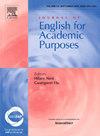被动语态在理科生写作中的运用
IF 3.4
1区 文学
Q1 EDUCATION & EDUCATIONAL RESEARCH
引用次数: 0
摘要
被动语态一直不受教科书写作的鼓励(Pullum, 2014),但它仍然是学术科学写作的一个关键特征,并且在研究文章(Leong, 2014, 2020)和本科科学教科书(Luo, 2018)中非常频繁。在功能上,被动语态被认为有助于文本的逻辑信息结构(Biber et al., 1999; Halliday, 1988)以及实现客观语态(Ding, 2002)。对于那些以英语为第二语言的人来说,被动语态很难习得,并且在将英语作为第二语言的作者中使用的频率较低(Hinkel, 2002a)。本文的重点是大学生科学实验报告。使用从英国学术书面英语语料库(BAWE)中抽取的小型实验室报告语料库,比较了以英语为第一语言(L1)和以英语为第二语言(L2)写作的作者对被动语态的使用频率和在研究文章中的使用情况。研究发现,本科科学实验报告的母语作者使用被动语态的频率与研究文章和教科书中使用被动语态的频率相当,而第二语言作者使用被动语态的频率要低得多。本文章由计算机程序翻译,如有差异,请以英文原文为准。
The use of the passive voice in science students’ writing
The passive voice has been discouraged by writing textbooks (Pullum, 2014), yet it remains a key register feature in academic science writing, and is highly frequent in research articles (Leong, 2014, 2020) and undergraduate science textbooks (Luo, 2018). Functionally the passive voice is considered as contributing to logical information structure of the text (Biber et al., 1999; Halliday, 1988) as well as to achieving an objective voice (Ding, 2002). The passive can be difficult to acquire for those for whom English is a second language and is used at lower frequencies by writers using English as a second language (Hinkel, 2002a) .
The focus of this article is undergraduate science laboratory reports. Using a small corpus of laboratory reports, drawn from the British Academic Written English corpus (BAWE), use of the passive voice by writers of English as a first language (L1) and those writing in English as a second language (L2) was compared with its frequency and use in research articles. L1 writers of undergraduate science laboratory reports were found to use the passive about as frequently as it is used in research articles and textbooks, while L2 writers used it much less frequently.
求助全文
通过发布文献求助,成功后即可免费获取论文全文。
去求助
来源期刊

Journal of English for Academic Purposes
Multiple-
CiteScore
6.60
自引率
13.30%
发文量
81
审稿时长
57 days
期刊介绍:
The Journal of English for Academic Purposes provides a forum for the dissemination of information and views which enables practitioners of and researchers in EAP to keep current with developments in their field and to contribute to its continued updating. JEAP publishes articles, book reviews, conference reports, and academic exchanges in the linguistic, sociolinguistic and psycholinguistic description of English as it occurs in the contexts of academic study and scholarly exchange itself.
 求助内容:
求助内容: 应助结果提醒方式:
应助结果提醒方式:


